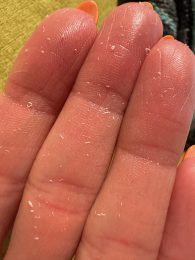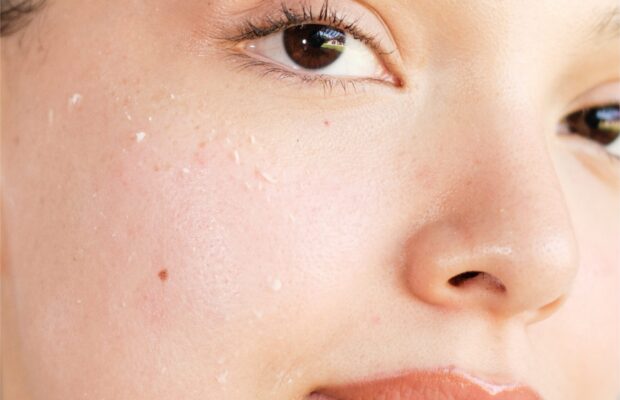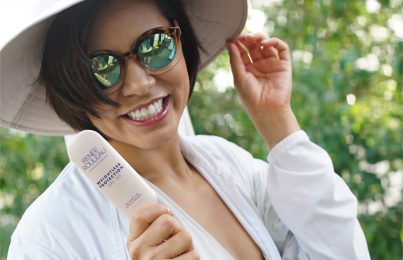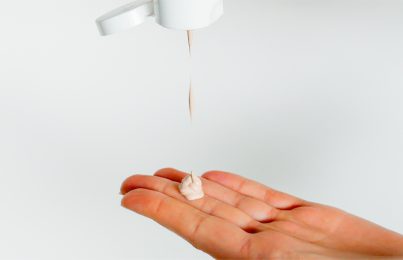Clean face? Check! Favorite Serums? Check! Daily application of sunscreen… and wait, what are those white blobs?
We all know that wearing sunscreen is a must at this point, so it’s not too surprising if some of you have started to notice small white blobs, or “pills,” occasionally forming after application. At the bare minimum, pilling is a waste of product, but it’s generally pretty frustrating as well. When something so integral to your daily routine causes such an unattractive result, it leaves you questioning what went wrong, and more importantly— how can it be prevented. So, let’s take a look at why these annoying pills form.
Why Does Sunscreen Pill?
When creating a sunscreen, there are a few key elements that a formulator must keep in mind. For one, they’ll want it to lay down on the skin and create a uniform film, allowing the sunscreen agents to disperse evenly. They will also want to ensure it stays put and doesn’t migrate on the skin. This is important to maintain the consistent, uniform coverage necessary to pass SPF testing. So typically, certain ingredients are incorporated to form films on the skin to keep it in place. Once the film is formed (depending on which ingredients were used), any rubbing on the sunscreen can break the film up and create what looks like pilling.
Which Ingredients Cause Pilling?
There are a few different ingredients to keep an eye out for when it comes to pilling. Gums are the most common (and easiest) film formers to use. Ingredients like guar gum, sclerotium gum, xanthan gum, and many others containing the word gum are commonly found in sunscreen. There are also polymers (like accolades, copolymers, or a variety of different silicone polymers) that are used to lock this film in place.
These ingredients do not pose a risk of pilling on their own, but rather when you’re applying sunscreen with other products like serums, moisturizers, or makeup. When pairing a sunscreen containing gums or polymers with another product containing gums or polymers, the two will grab onto each other or interact. Because they’re incompatible, this can lead to the dreaded pilling.
By either rubbing your sunscreen after application or incorporating additional products with polymers and gums, the sunscreen film can break up and form pills.
How Can Pilling Be Prevented?
Weekly Exfoliation
A thoughtful skincare routine is critical in creating a clean slate for all products to come. While pilling is, for the most part, a polymer interaction, texture from dirt or dead skin cells sitting on top of the skin can cause problems of their own. Dry skin, dead skin cells, and flaking skin can prevent sunscreen from being absorbed. This is why exfoliating one or two times a week is an excellent way to clear your skin and ensure maximum absorption of skincare products.
Read more about the various types of exfoliants and find out which one is right for you.
Take A Closer Look At The Products You Use
When trying to avoid pilling, it all comes down to selecting the right products and putting them together. Sometimes this means choosing which product you like better. If there’s a certain serum, moisturizer, or makeup product that you can’t go without, but it interacts with your sunscreen, you may need to look for a sunscreen that doesn’t contain the same gums or polymers. The same goes for if there’s a sunscreen you can’t live without. Unfortunately, there’s not much to do about that gum-on-gum interaction besides rotating through different products and determining which ones are compatible. Like so many things in skincare, learning what works best for your unique skin comes down to trial and error.
Seek Out Trusted Brands With Rigorous Testing Procedures
I’ve been the head of product development for my skincare line for over 27 years, and this has really taught me that following proper product testing procedures is key to ensuring a good user experience.
For example, I just recently began testing a new moisturizer for my line. One thing I always look at when formulating skincare products is to see how they react with other products. In this case, that means testing this moisturizer with every single serum in my line so that when it’s all said and done, I can confidently say all of our products work together without the risk of pilling. Lo and behold, I did run into a pilling problem with one of our serums, and guess what—I had to go back to rework the formula. Now this is all totally normal but essential for providing a product that not only does what it says it’s going to do but also provides a great user experience (and definitely no pilling!).
While I can never be sure how a product will react with another outside of my line, it’s my mission to do as much as humanly possible in terms of testing formulas, ingredients, different viscosities, and anything else necessary to ensure a good interaction.

So, Why Not Formulate Sunscreen Without Gums and Polymers?
Simply put, gums, elastomers, and different polymers are critical to helping boost the SPF value of a product. They ensure that the protective film forms properly on the skin and disperses the UV filters evenly, providing the best SPF value and the best sun protection possible. If formulators didn’t use these ingredients, it would be extremely difficult to develop high-performing sunscreens that meet (and maintain) SPF standards on the skin.
At the end of the day, these sunscreens are very nice, stable products that just so happen to interact with another nice, stable product. Unfortunately, this is just something that has to be navigated by selecting products that work together.
Three Common Misconceptions About Sunscreen Pilling
Myth #1: Application Techniques Can Prevent Pilling
Unfortunately, this is not the case. From a physical aspect, there’s little that can be done since you’re laying one film down on your skin and then laying another film over it. Once these layers are completely dry, pilling begins. Ultimately, it’s a chemical reaction and no technique will make a difference.
However, I always recommend layering your products from thinnest to thickest to ensure absorption of products and longer-lasting hydration.
Myth #2: Your Skin Type Affects Pilling
Nope! As I mentioned, this just happens to be a phenomenon that happens due to a chemical reaction—not your skin type.
Myth #3: The Amount Of Sunscreen Applied Affects Pilling
While it may affect the amount of pilling, using anything other than the recommended amount of sunscreen is never a good idea. Yes, applying less sunscreen may reduce pilling, but this limits its efficacy and protection, and likely means you’re not getting the advertised SPF. And vice versa, if your sunscreen is experiencing an interaction with other products, adding more could just make it worse. After all, if your products are causing an interaction, the more of them you use, the more you will pill.
Read more about how to apply sunscreen properly.
Finding the perfect combination of products can be a journey, but I hope this helps you navigate it a bit better. By taking the time to experiment and identify a solution to your pilling problems, you’re not only saving money but also providing your skin the best form of protection against UV rays.
Next up, find out which 5 skincare mistakes could be making your makeup less effective.
Celebrity Esthetician & Skincare Expert
As an esthetician trained in cosmetic chemistry, Renée Rouleau has spent 30 years researching skin, educating her audience, and building an award-winning line of products. Her hands-on experience as an esthetician and trusted skin care expert has created a real-world solution — products that are formulated for nine different types of skin so your face will get exactly what it needs to look and feel its best. Trusted by celebrities, editors, bloggers, and skincare obsessives around the globe, her vast real-world knowledge and constant research are why Marie Claire calls her “the most passionate skin practitioner we know.”



